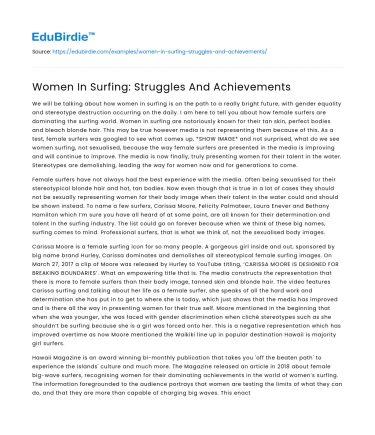We will be talking about how women in surfing is on the path to a really bright future, with gender equality and stereotype destruction occurring on the daily. I am here to tell you about how female surfers are dominating the surfing world. Women in surfing are notoriously known for their tan skin, perfect bodies and bleach blonde hair. This may be true however media is not representing them because of this. As a test, female surfers was googled to see what comes up, *SHOW IMAGE* and not surprised, what do we see women surfing, not sexualised, because the way female surfers are presented in the media is improving and will continue to improve. The media is now finally, truly presenting women for their talent in the water. Stereotypes are demolishing, leading the way for women now and for generations to come.
Female surfers have not always had the best experience with the media. Often being sexualised for their stereotypical blonde hair and hot, tan bodies. Now even though that is true in a lot of cases they should not be sexually representing women for their body image when their talent in the water could and should be shown instead. To name a few surfers, Carissa Moore, Felicity Palmateer, Laura Enever and Bethany Hamilton which I’m sure you have all heard of at some point, are all known for their determination and talent in the surfing industry. The list could go on forever because when we think of these big names, surfing comes to mind. Professional surfers, that is what we think of, not the sexualised body images.
Carissa Moore is a female surfing icon for so many people. A gorgeous girl inside and out, sponsored by big name brand Hurley, Carissa dominates and demolishes all stereotypical female surfing images. On March 27, 2017 a clip of Moore was released by Hurley to YouTube titling, ‘CARISSA MOORE IS DESIGNED FOR BREAKING BOUNDARIES’. What an empowering title that is. The media constructs the representation that there is more to female surfers than their body image, tanned skin and blonde hair. The video features Carissa surfing and talking about her life as a female surfer, she speaks of all the hard work and determination she has put in to get to where she is today, which just shows that the media has improved and is there all the way in presenting women for their true self. Moore mentioned in the beginning that when she was younger, she was faced with gender discrimination when cliché stereotypes such as she shouldn’t be surfing because she is a girl was forced onto her. This is a negative representation which has improved overtime as now Moore mentioned the Waikiki line up in popular destination Hawaii is majority girl surfers.
Hawaii Magazine is an award winning bi-monthly publication that takes you 'off the beaten path' to experience the Islands' culture and much more. The Magazine released an article in 2018 about female big-wave surfers, recognising women for their dominating achievements in the world of women’s surfing. The information foregrounded to the audience portrays that women are testing the limits of what they can do, and that they are more than capable of charging big waves. This enacts how women are not fragile and scared, they are strong, determined and can pursue anything they put their mind to. Big wave surfing has come a long way since the times of surfer, Buzzy Trent. Buzzy, a big wave surfer of the early 60’s made a lingering sentiment that has been absolutely obliterated by female surfers today. He said, “One thing I can’t stand is girls riding (or attempting to ride) big waves. Why? Well, you see, girls are much more emotional than men and therefore have a greater tendency to panic. Girls are better off and look more feminine riding average size waves.” This negative, sexist view of women has been demolished in society today and it’s great to see the media showing that that is no longer the case.
Multiple media texts gave been found showing gender equality and improved media representations in women surfing. Let’s end with the gender pay gap in women’s professional surfing closing on September 5th, 2018. Holy Moly! What an accomplishment for the surfing industry, hats off to the WSL for committing to equal pay for men and women. Prior to the decision in 2018, the 36 male surfers on WSL’s World Championship Tour were competing for $607,800 in prize money, while the 18 women on tour competed for just $303,900. Now that was just unfair. Wow just wow how the surfing industry has improved drastically in such a short time. A feature article was released on the WSL website on September 8th, 2018 headlining, ‘The World Surf League (WSL)Announces Prize Money Equality’. This was written in large bolded letters representing how it is an important commitment and accomplishment. A large bright image of professional male and female surfers with their hands united, smiling at the camera is shown as soon as the article is opened. By showing this image of all surfers wearing the same swimwear united together it represents how women are being treated as the talented athletes they are instead of being sexualised. Words and phrases that really stand out in the article are, ’Prize money equality, gender equality, highly talented, iconic role models,’ showing that women are represented with the fairness and regard they deserve. Representing how it isn’t hard to achieve gender equality, inspiring other worldly organisations to do the same. Good on the media for presenting it how it is.
I can say now that women are finally getting the respect and recognition they deserve. I call that this continues to happen and that female surfers in the media continue to be acknowledged for their triumphs and talents in the water.






 Stuck on your essay?
Stuck on your essay?

